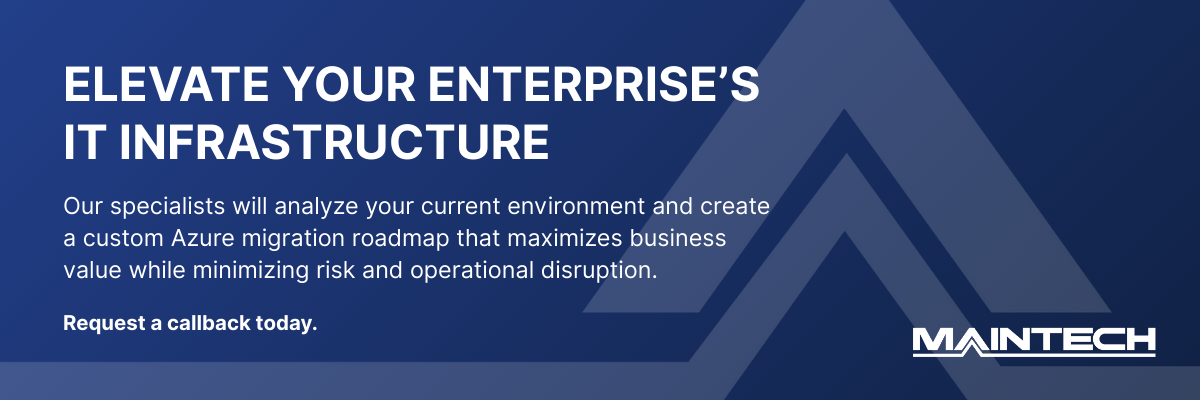While your on-premises infrastructure requires constant maintenance, expensive upgrades, and dedicated physical space, forward-thinking competitors are gaining competitive advantage through cloud transformation.
Far from being ‘just another hosting option,’ Microsoft Azure is a strategic platform that fundamentally transforms how enterprises deploy, manage, and optimize their critical IT resources. In our opinion, these are the five most significant benefits of moving to Azure that are encouraging C-suite executives to accelerate their cloud journey.
Why You Should Move to Azure: At a Glance
- Enterprise-Grade Reliability: Ensure business continuity with a global infrastructure network that eliminates costly service disruptions.
- 100% Remote Management: Free your IT team from physical infrastructure constraints with resources they can deploy, scale, and manage from anywhere in the world.
- Elimination of Hardware Cycles: Transform unpredictable capital expenses into manageable operational costs (while gaining the agility to scale resources based on actual business demand).
- Microsoft Ecosystem Integration: Maximize your existing Microsoft investments through seamless integration that enhances productivity, security, and user experience across your digital workspace.
- Built-In Optimization Tools: Continuously improve performance while controlling costs through intelligent monitoring and automated recommendations.
Gain Unmatched Reliability and Performance at Scale
Azure’s global infrastructure spans more than 60 regions with 200+ data centers strategically positioned worldwide, providing reliability that on-premises solutions (even in large enterprises) struggle to match.
This distributed architecture delivers several key advantages, including:
- 99% uptime guarantees for many services
- Geographic redundancy that protects against regional outages or disasters
- Edge computing capabilities that place computing resources closer to end users
- Auto-scaling that adjusts resources based on demand patterns
These Azure cloud advantages for enterprises translate to consistent performance regardless of user location – particularly noteworthy for those with global organizations.
Unlike colocation arrangements that tie you to specific geographic locations and physical infrastructure, Azure’s distributed architecture ensures your applications and data remain accessible (with minimal latency) across all regions.
Better still, it’s all without the complexity and expense of maintaining multiple colocation contracts and hardware deployments worldwide (something we’ve helped clients address before).
Remote-First Infrastructure with Full Control
One of the most transformative Azure migration benefits is the ability to manage your entire infrastructure remotely. This capability has become increasingly valuable as organizations embrace distributed work models, since it enables you to:
- Configure, monitor, and maintain all resources through a unified management portal
- Deploy and scale applications without physical access to servers
- Implement infrastructure-as-code for consistent, repeatable deployments
- Conduct virtual machine maintenance without scheduling visits to your colocation space
This remote management paradigm eliminates dependencies on NOC visits, “smart hands” services, and in-person upgrades that often create bottlenecks in traditional environments. With Azure, your IT team maintains complete control while gaining location independence, a critical advantage in today’s distributed business landscape.
No More Costly Hardware Refresh Cycles
Perhaps the most compelling financial benefit of moving to Azure is the elimination of hardware refresh cycles that traditionally consume significant capital and operational resources.
With Azure, you can:
- Transition from capital expenditure (CapEx) to operational expenditure (OpEx) models
- Avoid over-provisioning for “peak” workloads by paying only for resources you actually use
- Eliminate costs associated with colocation contracts, power consumption, cooling requirements, and physical security dependencies
- Reduce the time IT staff spend on hardware maintenance and troubleshooting
The Infrastructure-as-a-Service model allows enterprises to scale resources up or down based on actual needs, eliminating the significant upfront investments traditionally required when expanding capacity.
For organizations currently using colocation services, Azure also eliminates additional operational friction points: rack space limitations that restrict growth, long-term contract commitments that reduce flexibility, cross-connect fees that escalate with bandwidth needs, and the delays inherent in shipping, installing, and configuring new hardware in remote facilities.
This flexibility is particularly valuable for workloads with seasonal or unpredictable demand patterns, where traditional infrastructure would sit idle during low-demand periods.
Azure Cloud Advantages for Enterprises: Seamless Integration with Microsoft 365 and More
If, like millions of other businesses, you’re already invested in the Microsoft ecosystem, the seamless integration between Azure and other Microsoft products represents one of the strongest Azure migration benefits:
- Single sign-on across Microsoft 365, Teams, and Azure resources
- Simplified identity management through Azure Active Directory
- Enhanced security through Microsoft Defender integration
- Streamlined compliance and governance across the entire Microsoft stack
This integration creates operational efficiencies by reducing the number of separate systems administrators need to manage and monitor. Users benefit from consistent experiences across applications, while security teams gain comprehensive visibility across all Microsoft services.
Built-In Tools for Efficiency, Governance, and Cost Control
The final compelling reason why you should move to Azure lies in the platform’s sophisticated built-in tools for optimizing operations and controlling costs:
- Azure Advisor provides personalized recommendations for improving performance, security, and cost efficiency
- Azure Cost Management enables detailed tracking and analysis of cloud spend
- Azure Policy allows implementation of governance controls at scale
- Azure Monitor delivers comprehensive observability across your environment
Our Azure specialists assist organizations like yours in implementing right-sizing recommendations, reserved instance purchases, and other cost optimization strategies that can reduce cloud expenditure compared to unoptimized deployments.
Maximize the Benefits of Moving to Azure with Maintech
While Azure offers powerful capabilities out of the box, realizing its full potential requires strategic planning and ongoing optimization.
We offer comprehensive support throughout your cloud journey, including:
- Assessment and migration planning tailored to your specific business requirements
- Implementation of Azure landing zones that provide secure, scalable foundations
- Integration of advanced features like machine learning and business analytics
- Continuous optimization of performance, security, and cost
By partnering with Maintech, you gain not just technical expertise but a strategic advisor committed to aligning your Azure environment with your business objectives. Our vendor-neutral approach ensures recommendations that serve your interests, not alternative agendas.
Ready to Explore Azure?
Contact our cloud specialists today for a no-obligation consultation.


